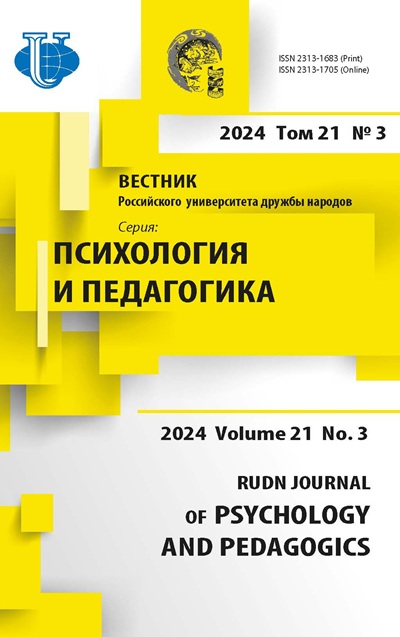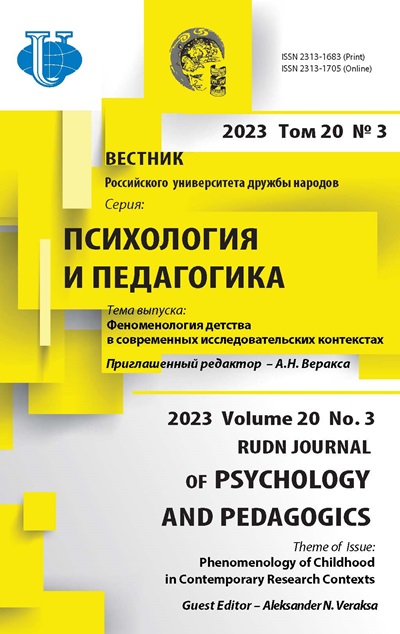Features of the Imagination in Preschoolers Playing Various Digital Games
- Authors: Bukhalenkova D.A.1, Chichinina E.A.1
-
Affiliations:
- Lomonosov Moscow State University
- Issue: Vol 20, No 3 (2023): Phenomenology of Childhood in Contemporary Research Contexts
- Pages: 482-500
- Section: DIGITALIZATION OF CHILDHOOD: RISKS AND OPPORTUNITIES
- URL: https://journals.rudn.ru/psychology-pedagogics/article/view/36960
- DOI: https://doi.org/10.22363/2313-1683-2023-20-3-482-500
- EDN: https://elibrary.ru/BTOVLF
Cite item
Full Text
Abstract
Due to the fact that in the life of modern preschoolers the traditional role-playing game with peers is increasingly being replaced by playing on digital devices, many researchers have expressed concern about how well their imagination develops. However, other scientists, on the contrary, see the potential for developing children’s imagination in digital games and applications. For this reason, the study is focused on differences in the productive imagination among preschoolers who prefer different types of games on digital devices. The authors propose a typology of digital games played by the preschoolers. A survey was conducted on the use of digital devices among 450 children aged 5-6 years who attended preparatory groups of kindergartens from four regions of Russia, and their imagination was assessed using the “Completing Figures” technique (by O.M. Dyachenko) and a questionnaire developed as part of the study for educators on behavioral manifestations of imagination in their pupils (42 educators were involved). Based on the results of a survey of the educators, it was found that they evaluated the results of creative productive activity lower in the children who liked games for reaction speed than in those who did not play such games. At the same time, the educators rated this parameter of imagination higher in children playing simulation games compared to those who did not play them. The results of the “Completing Figures” technique showed that the children playing logic games had significantly higher ratings for the elaboration of drawings than those who did not play games of this type, and the parameter of originality of the drawings was lower in the children playing strategic games compared to those who did not play them. The typology of digital games proposed by the authors of the study and the data obtained can be useful in conducting scientific research on the digitalization of modern childhood and in developing recommendations for parents of preschoolers.
Keywords
About the authors
Daria A. Bukhalenkova
Lomonosov Moscow State University
Author for correspondence.
Email: d.bukhalenkova@inbox.ru
ORCID iD: 0000-0002-4523-1051
SPIN-code: 5050-7236
Ph.D. in Psychology, is Associate Professor of Educational Psychology and Pedagogy Department, Faculty of Psychology
11 Mokhovaya St, bldg 9, Moscow, 125009, Russian FederationElena A. Chichinina
Lomonosov Moscow State University
Email: alchichini@gmail.com
ORCID iD: 0000-0002-7220-9781
SPIN-code: 1007-9720
Researcher of Educational Psychology and Pedagogy Department, Faculty of Psychology
11 Mokhovaya St, bldg 9, Moscow, 125009, Russian FederationReferences
- Åkerman, P., & Puikkonen, A. (2011). Prochinima: Using pico projector to tell situated stories. MobileHCI '11: Proceedings of the 13th International Conference on Human Computer Interaction with Mobile Devices and Services (pp. 337–346). New York: Association for Computing Machinery. https://doi.org/10.1145/2037373.2037425
- Andreeva, O.S., Ershova, I.A., & Rusyaeva, I.A. (2016). Research on the relationship between intelligence, creativity and degree of immersion in computer games among pre-school children. Izvestija Ural'skogo Federal'nogo Universiteta. Serija 1: Problemy Obrazovanija, Nauki i Kul'tury, 22(3), 120‒127. (In Russ.)
- Antle, A. (2003). Case study: The design of CBC4Kids' StoryBuilder. IDC '03: Proceedings of the 2003 Conference on Interaction Design and Children (pp. 59–68). New York: Association for Computing Machinery. https://doi.org/10.1145/953536.953546
- Behnamnia, N., Kamsin, A., & Ismail, M.A.B. (2020). The landscape of research on the use of digital game-based learning apps to nurture creativity among young children: A review. Thinking Skills and Creativity, 37, 100666. https://doi.org/10.1016/j.tsc.2020.100666
- Belova, E.S. (2022). Psychological aspects of using digital devices for the development of older preschoolers with signs of giftedness. RUDN Journal of Psychology and Pedagogics, 19(4), 649‒669. (In Russ.) https://doi.org/10.22363/2313-1683-2022-19-4-649-669
- Belova, E.S., & Shumakova, N.B. (2022). Features of the use of digital devices as components of a family microenvironment for the cognitive development of older preschoolers. Preschool Education Today, (6), 42–53. (In Russ.) https://doi.org/10.24412/2782-4519-2022-6114-42-53
- Blanco-Herrera, J.A., Gentile, D.A., & Rokkum, J.N. (2019). Video games can increase creativity, but with caveats. Creativity Research Journal, 31(2), 119–131. https://doi.org/10.1080/10400419.2019.1594524
- Bogacheva, N.V. (2014). Computer games and cognitive specifics of gamers. Moscow University Psychology Bulletin, (4), 120‒130. (In Russ.)
- Bukhalenkova, D.A., & Almazova, O.V. (2023, in press). Assessment of imagination characteristics in older preschoolers by educators. National Psychological Journal, 18(4).
- Calver, S.L. (2015). Children and digital media. Media, Imaginative Play, Creativity, and Daydreaming (сhapter 10, pp. 386‒388). Retrieved March 20, 2023, from http://cdmc.georgetown.edu/wp-content/uploads/2015/03/10-Calvert-HOCPADS-7e-V4-c10_FINAL_2015.pdf
- Calvert, S.L., & Valkenburg, P.M. (2013). The influence of television, video games, and the internet on children’s creativity. In M. Taylor (Ed.), The Oxford Handbook of the Development of Imagination (pp. 438–450). Oxford: Oxford University Press. https://doi.org/10.1093/oxfordhb/9780195395761.013.0028
- Cassell, J., & Ryokai, K. (2001). Making space for voice: Technologies to support children’s fantasy and storytelling. Personal and Ubiquitous Computing, 5(3), 169–190. https://doi.org/10.1007/pl00000018
- Djachenko, O.M. (1996). The development of the imagination of a preschooler. Moscow: International Educational and Psychological College. (In Russ.)
- Djachenko, O.M. (2007). The development of the imagination of a preschooler: Methodological guide for educators and parents. Moscow: Mozaika-Sintez Publ. (In Russ.)
- Garaigordobil, M., & Berrueco, L. (2011). Effects of a play program on creative thinking of preschool children. Spanish Journal of Psychology, 14, 608‒618. https://doi.org/10.5209/rev_SJOP.2011.v14.n2.9
- Götz, M. (2013). Media, imagination and fantasy. In D. Lemish (Ed.), The Routledge International Handbook of Children, Adolescents and Media (1st ed.) (pp. 212‒218). London: Routledge. https://doi.org/10.4324/9780203366981-37
- Greenfield, P.M. (2009). Technology and informal education: What is taught, what is learned. Science, 323(5910), 69–71. https://doi.org/10.1126/science.1167190
- Hamlen, K.R. (2013). Trends in children's video game play: Practical but not creative thinking. Journal of Educational Computing Research, 49, 277‒291. https://doi.org/10.2190/EC.49.3.a
- Jackson, L.A., Witt, E.A., Games, A.I., Fitzgerald, H.E., von Eye, A., & Zhao, Y. (2012). Information technology use and creativity: Findings from the children and technology project. Computers in Human Behavior, 28(2), 370–376. https://doi.org/10.1016/j.chb.2011.10.006
- Jelkonin, D.B. (1978). The psychology of play. Moscow: Pedagogika Publ. (In Russ.)
- Kannetis, T., Potamianos, A., & Yannakakis, G.N. (2009). Fantasy, curiosity and challenge as adaptation indicators in multimodal dialogue systems for preschoolers. WOCCI '09: Proceedings of the 2nd Workshop on Child, Computer and Interaction (pp. 1–6). New York: Association for Computing Machinery. https://doi.org/10.1145/1640377.1640378
- Klopotova, E.E., & Romanova, Yu.A. (2020). Computer games as a factor in the cognitive development of preschoolers. Bulletin of Practical Psychology of Education, 17(1), 32–40. (In Russ.) https://doi.org/10.17759/bppe.2020170104
- Kravtsov, G.G., & Kravtsova, E.E. (2019). Imagination and creativity: Culturalhistorical approach. Psychological-Educational Studies, 11(1), 1‒11. (In Russ.) https://doi.org/10.17759/psyedu.2019110101
- Linebarger, D.L., Barr, R., Lapierre, M.A., & Piotrowski, J.T. (2014). Associations between parenting, media use, cumulative risk, and children’s executive functioning. Journal of Developmental & Behavioral Pediatrics, 35(6), 367–377. https://doi.org/10.1097/dbp.0000000000000069
- Lucchiari, C., Sala, P.M., & Vanutelli, M.E. (2019). The effects of a cognitive pathway to promote class creative thinking. An experimental study on Italian primary school students. Thinking Skills and Creativity, 31, 156–166. https://doi.org/10.1016/j.tsc.2018.12.002
- Maslova, Ju.V. (2013). Positive and negative aspects of the use of computer technologies in children and adolescents. Educational Technology & Society, 16(4), 493–503. (In Russ.)
- McNeill, J., Howard, S.J., Vella, S.A., & Cliff, D.P. (2019). Longitudinal associations of electronic application use and media program viewing with cognitive and psychosocial development in preschoolers. Academic Pediatrics, 19(5), 520–528. https://doi.org/10.1016/j.acap.2019.02.010
- Ott, M., & Pozzi, F. (2012). Digital games as creativity enablers for children. Behaviour & Information Technology, 31(10), 1011–1019. https://doi.org/10.1080/0144929x.2010.526148
- Papadakis, S. (2021). Tools for evaluating educational apps for young children: A systematic review of the literature. Interactive Technology and Smart Education, 18(1), 18‒49. https://doi.org/10.1108/itse-08-2020-0127
- Rahimi, S., & Shute, V.J. (2021). First inspire, then instruct to improve students’ creativity. Computers & Education, 174, 104312. https://doi.org/10.1016/j.compedu.2021.104312
- Rubtsova, O.V., & Salomatova, O.V. (2022). Children's Play in the context of digital transformation: Cultural and historical perspective (part 2). Cultural-Historical Psychology, 18(4), 15‒26. (In Russ.) https://doi.org/10.17759/chp.2022180402
- Singer, D.G., & Singer, J.L. (2005). Imagination and play in the electronic age. Cambridge: Harvard University Press. https://doi.org/10.4159/9780674043695
- Veraksa, A.N., Almazova, O.V., Bukhalenkova, D.A., & Chichinina, E.A. (2020). Digital devices use by 6-7 years-old children. Sotsiologicheskie Issledovaniya, (6), 82–92. (In Russ.) https://doi.org/10.31857/S013216250009455-3
- Veraksa, N., Veraksa, A., Gavrilova, M., Bukhalenkova, D., Oshchepkova, E., & Chursina, A. (2021). Shortand long-term effects of passive and active screen time on young children’s phonological memory. Frontiers in Education, 6, 600687. https://doi.org/10.3389/feduc.2021.600687
- Vygotskii, L.S. (1982). Imagination and its development in childhood. In V.V. Davydov (Ed.), The Collected Works. Vol. 2. Problems of General Psychology (pp. 436‒454). Moscow: Pedagogika Publ. (In Russ.)
- Xiong, Z., Liu, Q., & Huang, X. (2022). The influence of digital educational games on preschool children's creative thinking. Computers & Education, 189, 104578. https://doi.org/10.1016/j.compedu.2022.104578
- Yudina, E.G. (2022). Pretend play as the territory of freedom. National Psychological Journal, (3), 13–25. (In Russ.) https://doi.org/10.11621/npj.2022.0303

















